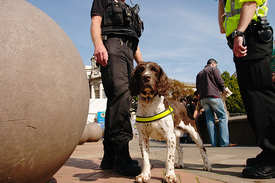Researchers create remote guidance system that allows canine handlers to guide dogs from a distance
Military, security and law enforcement operations may have a new trick up their sleeve in dealing with dicey situations.

flickr photo courtesy of Mike Warren
Major, a trained yellow Lab tested a new system at Canine Detection Research Institute that implements a GPS, sensors, a processor and a radio modem. These components are all connected wirelessly to a computer system, which is attached to a custom harness that the canine wears. The dog is guided by sensing slight vibrations on the left or right side of the harness, and different audible tones.
Remote guidance isn't a new concept: in the past, the idea utilized invasive implanted electrodes to give commands to other species of animals. This new technology allows for a longer range between canine and handler — and possibly the option of a handler overseeing more than one dog at once.
David M. Bevly, an associate professor of mechanical engineering at Auburn University created the navigation system with his team.
Applications where this type of remote guidance could prove very useful are in drug detection, airport security inspection and in combat zones to deliver medical aid. It would offer flexibility in utilizing resources, and most importantly, the ability to be discreet.
Read more details here about the study's findings.
The results from test were promising; the computer delivered commands with 99 percent accuracy, and the dog got things right 80 percent of the time.
Lorrie Shaw has written about the Veterinary Corps and Military Working Dogs on AnnArbor.com's pets section as a regular contributor. Follow her pet adventures as owner of Professional Pet Sitting on Twitter.

